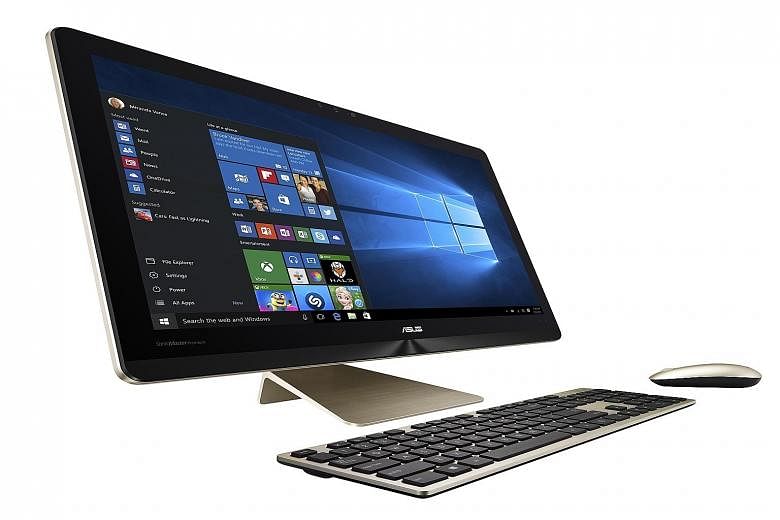From afar, it is easy to mistake the Asus Zen AiO Pro for Apple's popular iMac. Both all-in-one computers look like beefy monitors with a bulge at the back.
But up close, the differences become apparent. Both have an aluminium chassis. However, the Asus' gold finish with gleaming diamond-cut edges along its bezel looks nothing like the iMac's matte silver finish.
The Asus is available in two sizes: 21.5 inches and 23.8 inches. There is a 21.5-inch iMac, but the next larger version is a 27-inch model.
Asus offers the 4K display resolution for this series, but only in other markets. The models in Singapore come with a 1,920 x 1,080-pixel screen. In comparison, Apple's iMac offers a 4K display option for the 21.5-inch iMac, and a 5K screen for the 27-inch.
Another feature that did not make it to Asus' local sets is the Intel 3D camera. This camera would have enabled users to log in to the computer via facial recognition.
-
TECH SPECS
-
PRICE: $2,198
PROCESSOR: Intel Core i7-6700T
GRAPHICS: Nvidia GeForce GTX 960M 2GB GDDR5
RAM: 16GB DDR4
SCREEN: 23.8-inch, 1,920 x 1,080 pixels
CONNECTIVITY: 4 x USB 3.0, 1 x USB 2.0, 1 x USB 3.1 Type-C, 2 x HDMI-out, Gigabit Ethernet, SD card reader, audio jacks
-
RATING
-
FEATURES: 3/5
DESIGN: 4/5
PERFORMANCE: 3/5
VALUE FOR MONEY: 3/5
OVERALL: 3/5
The Asus' glossy screen can be a tad reflective in a well-lit environment, but its in-plane switching display offers good viewing angles. Unlike the iMac, the Asus has a touchscreen that works well with the Windows 10 operating system.
I have a couple of complaints about the design, though.
First, it uses an external power adapter, which adds clutter.
Also, the ports, which include a new reversible USB Type-C supporting faster data transfer speed, are located at the back of the Asus. This makes plugging in a USB device a bit of a hassle, especially as the display does not swivel.
I had tried an older Asus all-in-one PC with HDMI input before. I could simply connect that computer to another device, such as a console, via the HDMI input and the PC could function as a monitor.
This feature is missing in the Zen AiO, which comes with two HDMI outputs instead. You can use the Asus to drive two displays, including TVs and projectors.
The optical drive is also missing on the Asus. This is not that surprising because most PC-makers have removed it from their devices.
The iMac does not have one either, but it is still disappointing not to find this option on a desktop computer.
The Asus has a dedicated Nvidia graphics chip that makes it suitable for gaming at modest graphics settings. Its GeForce GTX 960M is more powerful than the integrated Intel graphics on the iMac. I could run Bioshock Infinite smoothly at 58 frames per second at the highest setting.
But load times for apps and games were relatively long. The culprit is probably the slow 5,400RPM 1TB hard drive. Like the entry-level iMac, the Asus could do with a solid-state drive to improve the general responsiveness of the system.
Vincent Chang
• This all-in-one computer looks attractive and has decent graphics, but it could do with a solid-state drive.

